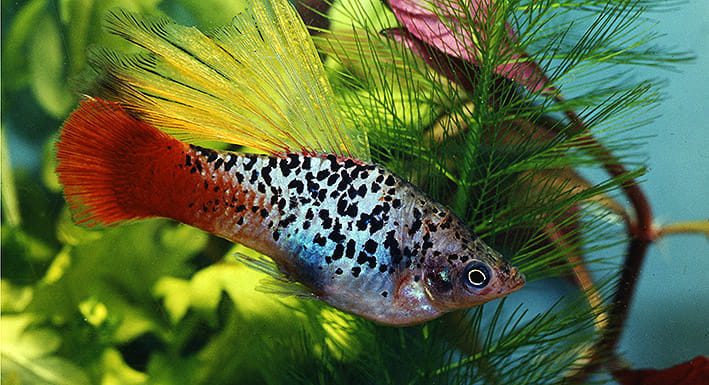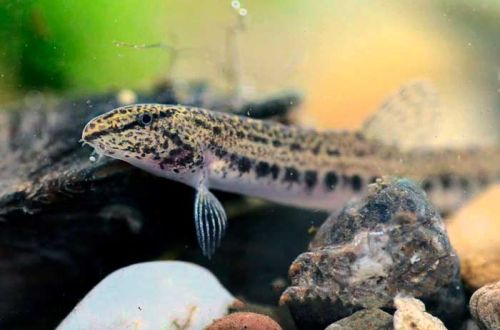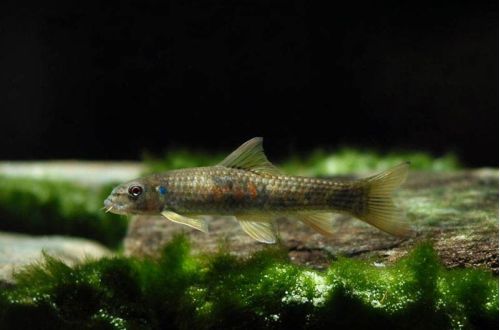
Pecilia tricolor
Pecilia tricolor or Pecilia variatus is a Russian-language transcription of the scientific name Xiphophorus variatus, belongs to the Poeciliidae family. Along with the closely related Pecilia, it is one of the most common aquarium fish. Such a high popularity is due to low requirements for conditions of detention and simple breeding. Not the last role was played by bright coloring.

It was first brought to Europe in 1931. Over decades of artificial breeding, many new varieties have appeared, including hybrids with the already mentioned Pecilia (Xiphophorus maculatus) and Swordtails. At present, decorative varieties are more common in home aquariums than wild populations with their natural colors.
Contents
Habitat
It was originally considered an endemic species for small heavily overgrown reservoirs on the Atlantic slope of Mexico. However, with the development of aquarism, these fish found themselves in a new habitat for themselves, where they successfully took root.
The habitat has expanded to the whole of Central America, the islands of the Caribbean, the southern states of the United States. Now they inhabit river systems in Southeast Asia, the Far East and southern regions of Europe.
Brief information:
- The volume of the aquarium – from 60 liters.
- Temperature – 20-28°C
- Value pH — 7.0–8.2
- Water hardness – medium to high hardness (10-30 GH)
- Substrate type – any
- Lighting – moderate or bright
- Brackish water – acceptable at a concentration of 5-10 grams per liter of water
- Water movement – moderate
- The size of the fish is 5–7 cm.
- Food – any food
- Temperament – peaceful
- Content alone, in pairs or in a group
Description

Adults reach a length of 5–7 cm. Males are more brightly colored and smaller than females. Depending on the specific species, the color and pattern of the body may vary. The closest to the natural color is the silver body color with numerous dark speckles, a red tail and a yellow dorsal fin. It was the combination of these three colors that gave the species its name.
Food
They accept all types of dry, frozen and live food. Preference should be given to those in which herbal supplements are present.
Maintenance and care, arrangement of the aquarium
They are considered unpretentious and hardy species. Pecilia tricolor is able to live in settled tap water, provided that it has medium or high hardness values uXNUMXbuXNUMXb(GH indicator). In regions with soft water, you will have to resort to special reagents that increase hardness. Similar substances can be found at the nearest pet store or ordered online.

In a spacious, sparsely populated aquarium (for example, 100 liters for 2-3 fish), it is acceptable not to use a filtration system or use a simple airlift filter, subject to regular maintenance and weekly replacement of part of the water with fresh water.
Arrangement is arbitrary. Selected at the discretion of the aquarist. Nevertheless, there is one important condition – it is necessary to provide a sufficient number of shelters. A good choice would be thickets of living aquatic plants and natural driftwood.
Behavior and Compatibility
Peaceful friendly species, able to get along with all types of fish of comparable size and temperament. It is recommended to purchase a group of several males and females, and the latter should be more.
Breeding / breeding
Under favorable conditions, spawning occurs regularly with a frequency of once every 1–2 months. Like other viviparous species, Pecilia tricolor does not lay eggs, but gives birth to fully formed fry. Parents do not differ in caring for offspring, therefore, in order to avoid predation, it is advisable to transplant juveniles into a separate tank.
Fish diseases
The main cause of most diseases in the aquarium is the unsuitable environment for keeping fish. Due to its endurance and ability to adapt to various conditions, Pecilia tricolor can “forgive” a number of errors in the content. Therefore, when the first signs appear, it is necessary to check the composition of the water and the presence of dangerous concentrations of nitrogen cycle products. Read more about symptoms and treatments in the Aquarium Fish Diseases section.





